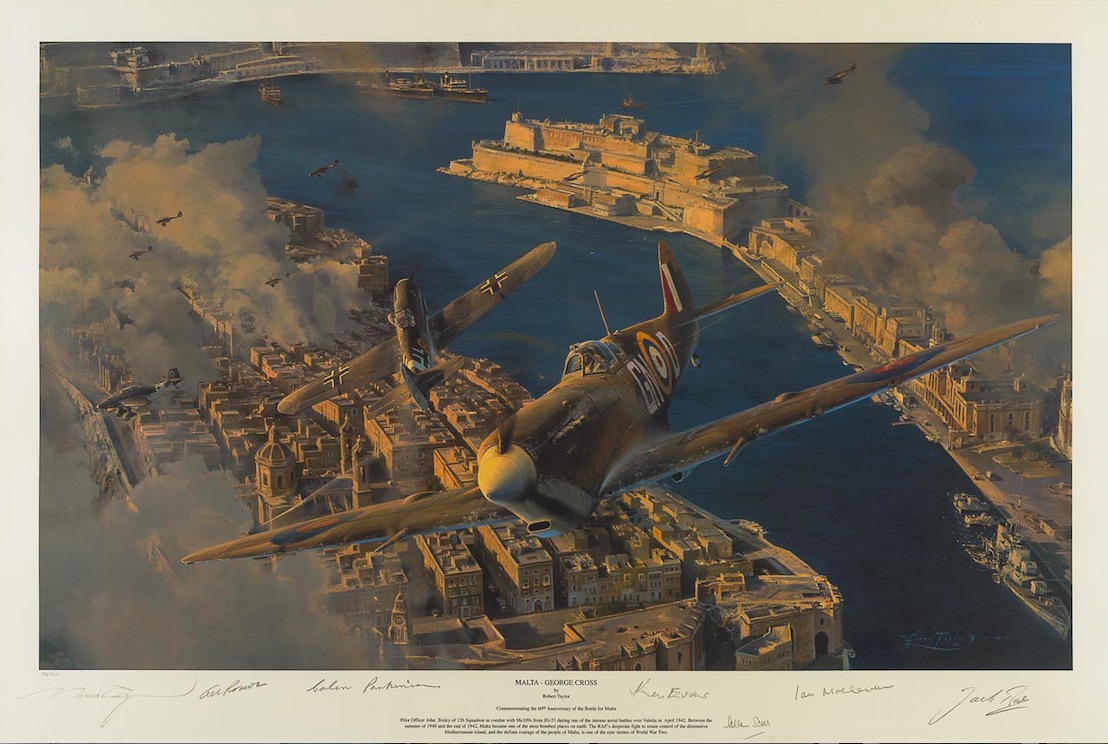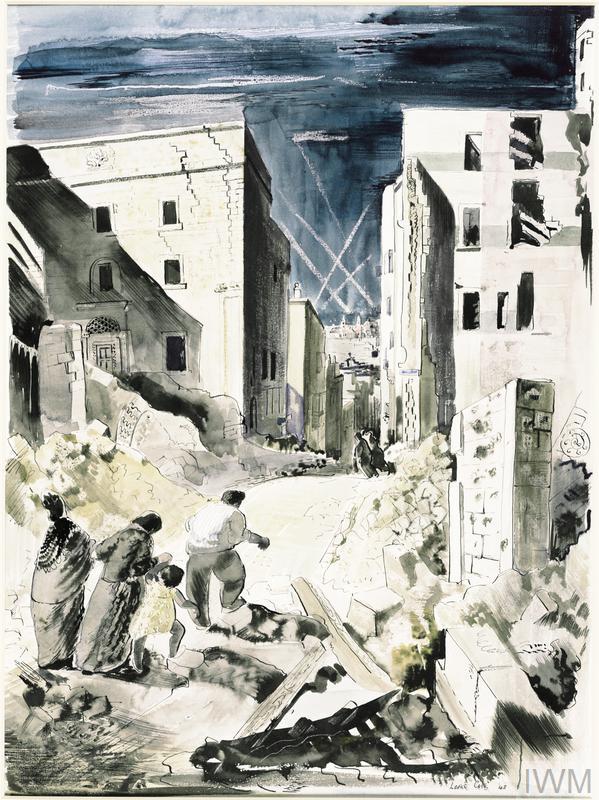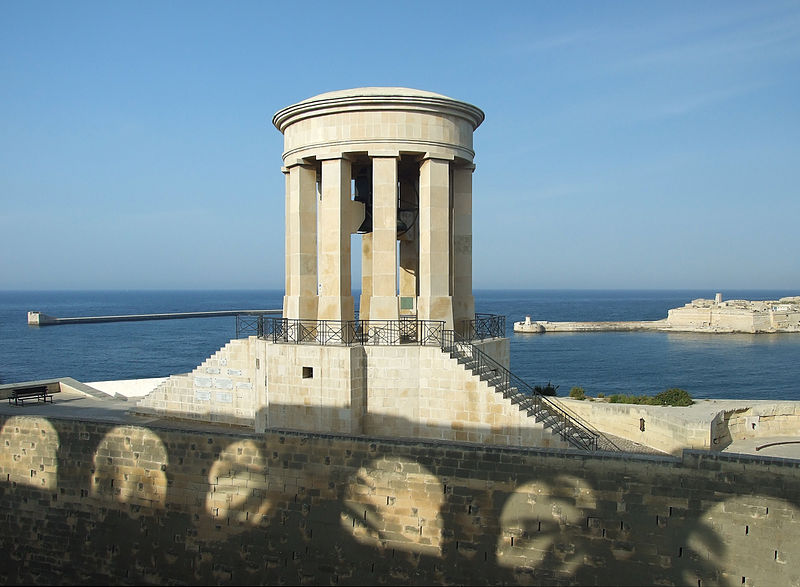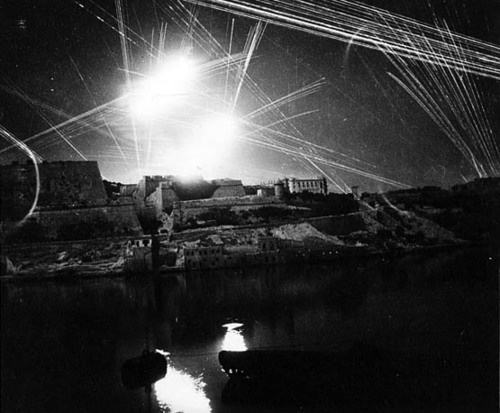MACLENNAN, Ian R (#128)

#128
Flight Lieutenant Ian MacLennan DFM RCAF (7 e/a)
Royal Air Force
April 4 1919 - November 6 2013
“Ian Maclennan is one of those men who make Canada tick”

Photo by Chris Sant Fournier (Times of Malta)
“Flight Lieutenant Ian MacLennan…was one of the last surviving fighter “aces” who engaged in fierce air battles during the Siege of Malta to secure the island’s survival.

Malta George Cross by Robert Taylor, signed by Ian MacLennan among several others, showing Mk V Spitfires duelling with ME109s over a besieged Malta.
MacLennan was a sergeant pilot flying Spitfires with No 401 (RCAF) Squadron in Britain when he crashed an aircraft. At the subsequent reprimand, his flight commander, rather pointedly, commented that “they are looking for volunteers for Malta”.
A few weeks later MacLennan was on board the carrier Eagle in the Mediterranean. On the morning of June 9 1942 he took off with 31 other pilots and headed for the isolated island. Four hours later, with very little fuel remaining, the Spitfires landed at Ta Kali airfield; within minutes, they were airborne with Malta-based pilots to repel a large raid by Luftwaffe bombers.
Before arriving in Malta, MacLennan had not fired his guns in anger – but he had figured out the grim business of shooting down the enemy: “I’d shot at ducks when I was a boy – I knew about deflection.” By the time he left Malta six months later he had become an “ace”, having destroyed seven enemy aircraft and damaging at least another eight.

Back Them Up! © IWM Art.IWM PST 14799
After damaging a Junkers 88 in July, MacLennan claimed his first success on August 10 when he shot down a Messerschmitt Bf 109 which was escorting a bomber force attacking Luqa airfield. Four days later he shot down an Italian fighter; its pilot was rescued from the sea.
With Malta suffering, living conditions for everyone, including pilots, were primitive. They faced relentless attacks, and few fighter pilots were under greater pressure. The intensity peaked on October 11 when “The Last Blitz” began.

St Lucius Street, Valletta: Moonlight alert by Leslie Cole (1943) © IWM Art.IWM ART LD 3509
MacLennan was in action immediately and damaged two enemy fighters over Grand Harbour. Later that day he intercepted a large force of Junkers 88 bombers as it approached the island. He dived into the formation, set one bomber on fire and shot down a second before attacking a third. He was hit by return fire but pressed on until his ammunition ran out.
On October 16 he was forced to crash land his badly damaged Spitfire but he returned to the battle and, by the end of the month, had accounted for three more fighters and some damaged bombers. He was awarded an immediate DFM for his “great courage and tenacity”. Commissioned, he returned to Britain.

An Impression of the Commemorative Vault built at Sagan showing Officers Working in the Grounds of Stalag Luft III
Cemetery by B. Ley Kenyon (1944) © IWM Art.IWM ART LD 4705
Ian Roy MacLennan was born in Regina, Canada, on April 4 1919. He attended school in Gull Lake, Saskatchewan, and studied engineering at Saskatchewan University before enlisting in the RCAF in October 1940. After training as a pilot he arrived in England in the summer of 1941.
He flew Spitfires on sweeps over France and on May 24 1942 damaged a Focke Wulf 190 off Calais. Shortly afterwards he left for Malta, where he joined No 1435 Flight.
After returning from Malta and a period of rest in Canada, MacLennan joined No 443 (RCAF) Squadron as a flight commander. On June 7 1944, whilst covering the D-Day landings, he was on his third sortie of the day strafing enemy positions when his Spitfire was hit by ground fire and he was forced to crash land on the beach behind enemy lines.

Model of the set used to film the movie The Great Escape. It depicts a smaller version of a single compound in Stalag Luft III. The model is now at the museum near where the prison camp was located.
MacLennan was sent to Stalag Luft III. In January 1945 the camp was evacuated as the Soviet army approached. He was in the camp hospital at the time and was put on a train, which headed southwards. Nearing the Austrian border, he and a colleague escaped and hid in farms until they were able to reach the American lines.
On his return to Canada, MacLennan attended Toronto University before embarking on a long and distinguished career as an architect, initially in Venezuela and the United States before returning to Canada. He focused on creating housing for low-income families and became chief architect, and later senior vice-president, of the Central and Mortgage Housing Corporation. In 1961 he was elected a Fellow of the Royal Architectural Institute of Canada.
For many years he shunned any publicity. But in 2009 a television company flew him to Malta, where he was given a hero’s welcome. A quiet, courteous, but plain-speaking man, his consuming passions included double bridge – he was a Life Master – and boating on French waterways in his 100-year old Dutch barge.
Ian MacLennan’s wife of almost 70 years, Nina, predeceased him. His son and daughter survive him.
Flt Lt Ian MacLennan, born April 4 1919, died November 6 2013″ (Obituary courtesy of The Daily Telegraph)

Malta: The Harbour Barrage from the Upper Barracca by Leslie Cole (1943) © IWM Art.IWM ART LD 3551

Malta: Fighters take off from Luca’s bombed runway by Leslie Cole (1943) © IWM Art.IWM ART LD 3554

Siege Bell War Memorial, Valletta, Malta. Designed by Michael Sandle and erected in 1992, it commemorates the victory of the Allied forces during the Second Siege of Malta from 1940-1943.
Mr McLennan has returned to Malta twice since 1942 – once to show the island to his wife and another time when Queen Elizabeth and then President Ċensu Tabone inaugurated the Siege Bell Memorial – a ceremony he described as “emotionally moving, I don’t know why… Well, yes,” he says, on second thoughts, “It was a victory bell really; the lifting of a siege…” of which he played a “small part”.
The fighter pilot remained in Malta from July to December 1942. “I was a young man…” Much time has passed but “it [the experience in Malta] made a big difference to me and my life”. He pauses to compose himself: “Even as a young man, I felt it was all wrong to be pounding the hell out of a beautiful place. People were dying…” He recalls an air raid and an older woman running to the shelter. He could see that she was terrified and tried to catch her to slow her down but “she flew, plunged and died”. He recalls the steel rings of that particular shelter and wants to know where it is…
The link to his past is evidently strong and Mr McLennan is reliving it. His Mdina connection is vivid. The pilot only spent one night in the mediaeval city and although all he did was rest and recover, having just landed off HMS Eagle, he still remembers the details and the novelty of the experience of sleeping under a mosquito net in a spacious room.
“I was taken into a beautiful place that resembled a nunnery, alone in a lovely bed. I felt tranquil…” Getting off the aircraft carrier was nerve-wracking, he recalls. “We had no (arrester) hooks so you could not land back and that was it! It is a harrowing one-off experience. Then there was the long flight here; then finding Malta; then Ta’ Qali; then to land…”
In 1942, he would wander around Valletta when he was on leave and when the Ohio sailed in, he remembers finding a way to climb up to see her. During his stay in Malta, he has nostalgically retraced his steps to the vantage point. And there were also a couple of dances they were invited to, “with beautiful Maltese girls, but they were guarded by machine gunners – their mothers and fathers – and they needed them”.
MacLennan was enlisted into the RCAF in October 1940. Following training, he graduated from training school in June 1941, arriving in England during that Summer.

Malta fighting at night
Malta
After service in Britain, flying sorties over France, in 1942 the RAF asked for desperately-needed volunteers (and their even more needed aircraft) to fight against Axis forces during the Siege of Malta. After damaging two Spitfires in an accident, MacLennan had fallen out of favor with his commanding officer and was asked to volunteer to go. On 9 June 1942, 32 pilots, MacLennan among them, headed towards Malta on board the aircraft carrier HMS Eagle. Roughly 1000 km (621 miles) from the island, the Spitfires were launched, attempting to fly through a hotbed of Axis aircraft and warships. After a four-hour flight, they landed, with little fuel left. Immediately, Malta-based pilots took over the aircraft, defending against a Luftwaffe attack.
MacLennan flew with No. 1435 Squadron, based at RAF Luqa and formed a good relationship with Canadian aces Squadron Leader Tony Lovell and Flight Lieutenant Henry Wallace McLeod; Lovell witnessed his first victory. MacLennan impressed his superiors with his gunnery skills and was promoted directly from flight sergeant to flight lieutenant and given command of “A” flight.During his time on Malta, MacLennan shot down seven enemy aircraft, becoming an ace.
On Malta, he also met George Beurling, the highest-scoring Canadian pilot of the Second World War, whom he highly regarded. However, the two never flew together.
Capture and escape
After the siege ended, MacLennan returned home for a period of rest. During D-Day, on 7 June 1944, his Spitfire crash-landed in enemy territory whilst supporting the allied landings. Captured, he was sent to Stalag Luft III, where he subsequently escaped in 1945, as the war was drawing to a close.
Postwar career
In 1945 MacLennan returned to Canada, studying at University of Toronto, where he was mentored by renowned Canadian architect Eric Arthur. A primary focus of his career in architecture was on producing affordable housing. His role took him to Venezuela, the United States and eventually back to his homeland of Canada. In 1961, he was made a Fellow of the Royal Architectural Institute of Canada, one of the youngest to be elected.
Moshe Safdie, famed designer of Habitat 67 said of him:
Ian Maclennan is one of those men who make Canada tick. Without him there would never have been a Habitat. He charges into meetings with the fervor of a college debating champion….he is aggressive, frank, and unlike many civil servants, very outspoken.
MacLennan appeared in two television documentaries, chronicling the Siege of Malta and the role played by Canadian Air Aces during the War.”



